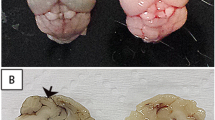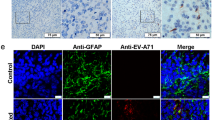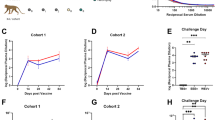Abstract
ACUTE encephalitis following measles infection in humans usually develops within a few days of the exanthema and can be fatal within 24 h. The presence of intracerebral infective measles virus in one such fatal human case may have been demonstrated by Shaffer et al.1 who inoculated a brain emulsion into two macaques and noted development of clinical measles. Animals also develop acute measles encephalitis. Suckling mice, rats and hamsters of varying ages have shown acute symptoms after intracerebral inoculation of neurotropic strains of measles virus2–4. The mouse model has been carefully studied5 using a mouse-adapted strain of measles virus and monitoring the virus by infectious assays and electron microscopy. The onset of symptons of encephalitis corresponded both to the development of a minimal level of infective virus within the brain and to the presence of observable nucleocapsids within the dying cell. The experimental study described here was undertaken to determine the effect of attenuated measles virus in newborn hamsters after intracerebral inoculation.
This is a preview of subscription content, access via your institution
Access options
Subscribe to this journal
Receive 51 print issues and online access
$199.00 per year
only $3.90 per issue
Buy this article
- Purchase on Springer Link
- Instant access to full article PDF
Prices may be subject to local taxes which are calculated during checkout
Similar content being viewed by others
References
Shaffer, M. F., Rake, G., and Hodes, H. L., Amer. J. Dis. Child., 64, 815 (1942).
Imagawa, D. T., and Adams, J. M., Proc. Soc. Exp. Biol. Med., 98, 567 (1958).
Burnstein, T., and Byington, D. P., Neurology, 18, 162 (1968).
Waksman, B. H., Burnstein, T., and Adams, R. D., J. Neuropathol. Exp. Neurol., 21, 25 (1962).
Wear, D. J., Rabin, E. R., Richardson, L. S., and Rapp, F., Exp. Mol. Pathol., 9, 405 (1968).
Rapp, F., J. Bact., 88, 1448 (1964).
Mirchamsy, H., and Rapp, F., J. Gen. Virol., 4, 513 (1969).
Richardson, L. S., Mirchamsy, H., and Rapp, F., Proc. Soc. Exp. Biol. Med., 132, 902 (1969).
Raine, C. S., Feldman, L. A., Sheppard, R. D., and Bornstien, M. B., J. Virol., 4, 169 (1969).
Pestri, T., Canad. Med. Assoc. J., 94, 1133 (1966).
Schneck, S. A., Fulginiti, V., and Leestma, J., Lancet, i, 1381 (1967).
Author information
Authors and Affiliations
Rights and permissions
About this article
Cite this article
WEAR, D., RAPP, F. Encephalitis in Newborn Hamsters after Intracerebral Injection of Attenuated Human Measles Virus. Nature 227, 1347–1348 (1970). https://doi.org/10.1038/2271347a0
Received:
Issue Date:
DOI: https://doi.org/10.1038/2271347a0
This article is cited by
-
The isolation of S.S.P.E. measles virus in newborn mice
Archiv f�r die gesamte Virusforschung (1974)
-
Properties of a measles virus neuropathic for rhesus monkeys
Archiv f�r die gesamte Virusforschung (1972)
-
Measles virus: Induced transfer of biological properties
Archiv f�r die gesamte Virusforschung (1972)
-
Markers for measles virus
Archiv f�r die gesamte Virusforschung (1972)
Comments
By submitting a comment you agree to abide by our Terms and Community Guidelines. If you find something abusive or that does not comply with our terms or guidelines please flag it as inappropriate.



